sensor VOLVO V60 2012 Owner's Manual
[x] Cancel search | Manufacturer: VOLVO, Model Year: 2012, Model line: V60, Model: VOLVO V60 2012Pages: 400, PDF Size: 9.28 MB
Page 181 of 400
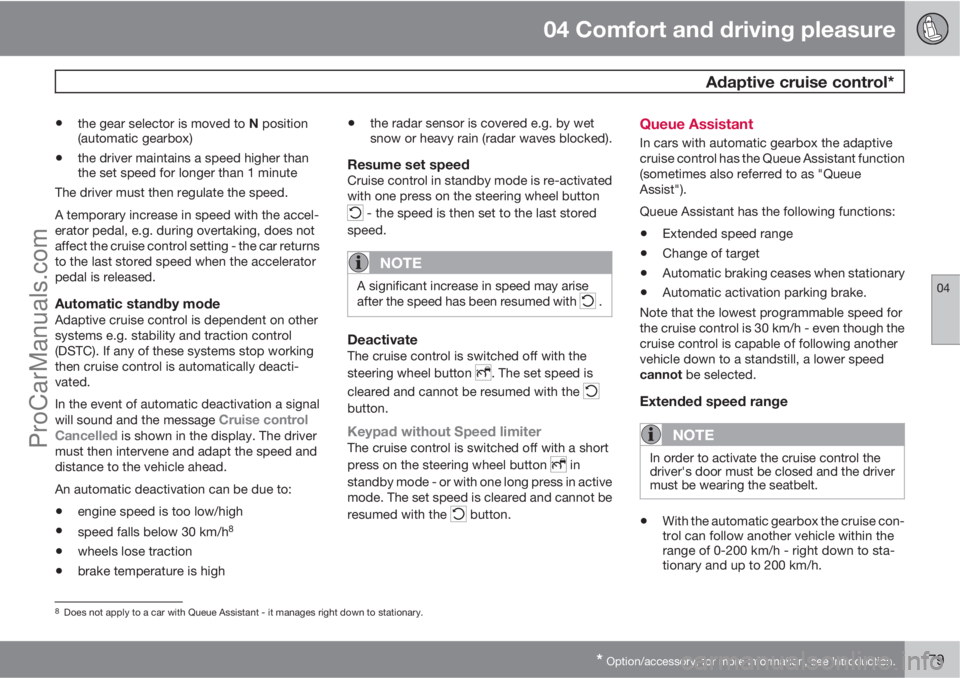
04 Comfort and driving pleasure
Adaptive cruise control*
04
* Option/accessory, for more information, see Introduction.179
•the gear selector is moved to N position
(automatic gearbox)
•the driver maintains a speed higher than
the set speed for longer than 1 minute
The driver must then regulate the speed.
A temporary increase in speed with the accel-
erator pedal, e.g. during overtaking, does not
affect the cruise control setting - the car returns
to the last stored speed when the accelerator
pedal is released.
Automatic standby modeAdaptive cruise control is dependent on other
systems e.g. stability and traction control
(DSTC). If any of these systems stop working
then cruise control is automatically deacti-
vated.
In the event of automatic deactivation a signal
will sound and the message
Cruise control
Cancelled is shown in the display. The driver
must then intervene and adapt the speed and
distance to the vehicle ahead.
An automatic deactivation can be due to:
•engine speed is too low/high
•speed falls below 30 km/h8
•wheels lose traction
•brake temperature is high
•the radar sensor is covered e.g. by wet
snow or heavy rain (radar waves blocked).
Resume set speedCruise control in standby mode is re-activated
with one press on the steering wheel button
- the speed is then set to the last stored
speed.
NOTE
A significant increase in speed may arise
after the speed has been resumed with .
DeactivateThe cruise control is switched off with the
steering wheel button
. The set speed is
cleared and cannot be resumed with the
button.
Keypad without Speed limiterThe cruise control is switched off with a short
press on the steering wheel button
in
standby mode - or with one long press in active
mode. The set speed is cleared and cannot be
resumed with the
button.
Queue Assistant
In cars with automatic gearbox the adaptive
cruise control has the Queue Assistant function
(sometimes also referred to as "Queue
Assist").
Queue Assistant has the following functions:
•Extended speed range
•Change of target
•Automatic braking ceases when stationary
•Automatic activation parking brake.
Note that the lowest programmable speed for
the cruise control is 30 km/h - even though the
cruise control is capable of following another
vehicle down to a standstill, a lower speed
cannot be selected.
Extended speed range
NOTE
In order to activate the cruise control the
driver's door must be closed and the driver
must be wearing the seatbelt.
•With the automatic gearbox the cruise con-
trol can follow another vehicle within the
range of 0-200 km/h - right down to sta-
tionary and up to 200 km/h.
8Does not apply to a car with Queue Assistant - it manages right down to stationary.
ProCarManuals.com
Page 183 of 400
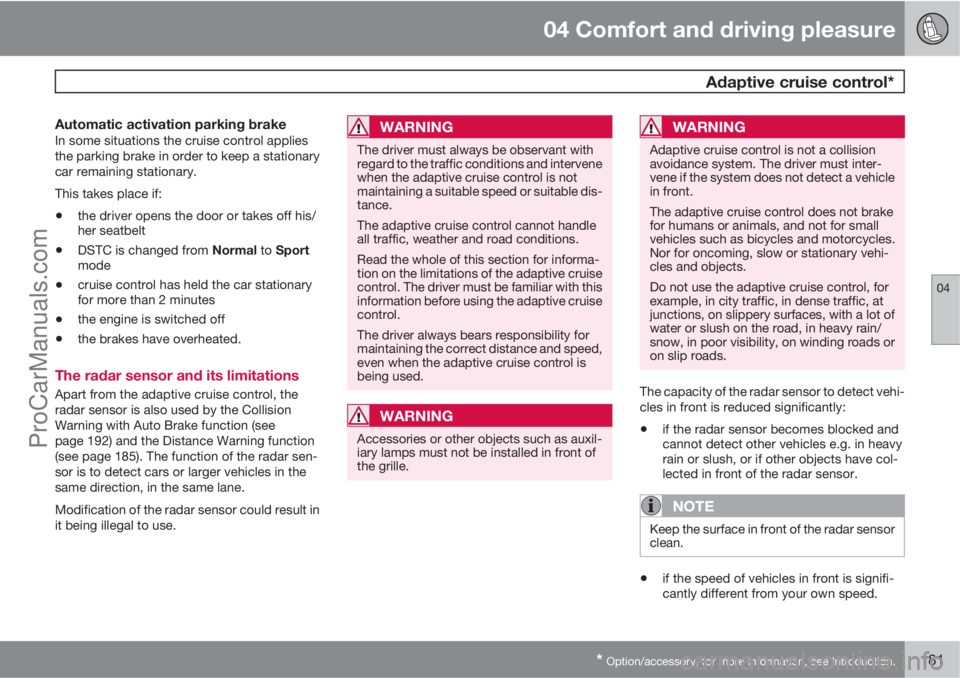
04 Comfort and driving pleasure
Adaptive cruise control*
04
* Option/accessory, for more information, see Introduction.181
Automatic activation parking brakeIn some situations the cruise control applies
the parking brake in order to keep a stationary
car remaining stationary.
This takes place if:
•the driver opens the door or takes off his/
her seatbelt
•DSTC is changed from Normal to Sport
mode
•cruise control has held the car stationary
for more than 2 minutes
•the engine is switched off
•the brakes have overheated.
The radar sensor and its limitations
Apart from the adaptive cruise control, the
radar sensor is also used by the Collision
Warning with Auto Brake function (see
page 192) and the Distance Warning function
(see page 185). The function of the radar sen-
sor is to detect cars or larger vehicles in the
same direction, in the same lane.
Modification of the radar sensor could result in
it being illegal to use.
WARNING
The driver must always be observant with
regard to the traffic conditions and intervene
when the adaptive cruise control is not
maintaining a suitable speed or suitable dis-
tance.
The adaptive cruise control cannot handle
all traffic, weather and road conditions.
Read the whole of this section for informa-
tion on the limitations of the adaptive cruise
control. The driver must be familiar with this
information before using the adaptive cruise
control.
The driver always bears responsibility for
maintaining the correct distance and speed,
even when the adaptive cruise control is
being used.
WARNING
Accessories or other objects such as auxil-
iary lamps must not be installed in front of
the grille.
WARNING
Adaptive cruise control is not a collision
avoidance system. The driver must inter-
vene if the system does not detect a vehicle
in front.
The adaptive cruise control does not brake
for humans or animals, and not for small
vehicles such as bicycles and motorcycles.
Nor for oncoming, slow or stationary vehi-
cles and objects.
Do not use the adaptive cruise control, for
example, in city traffic, in dense traffic, at
junctions, on slippery surfaces, with a lot of
water or slush on the road, in heavy rain/
snow, in poor visibility, on winding roads or
on slip roads.
The capacity of the radar sensor to detect vehi-
cles in front is reduced significantly:
•if the radar sensor becomes blocked and
cannot detect other vehicles e.g. in heavy
rain or slush, or if other objects have col-
lected in front of the radar sensor.
NOTE
Keep the surface in front of the radar sensor
clean.
•if the speed of vehicles in front is signifi-
cantly different from your own speed.
ProCarManuals.com
Page 184 of 400
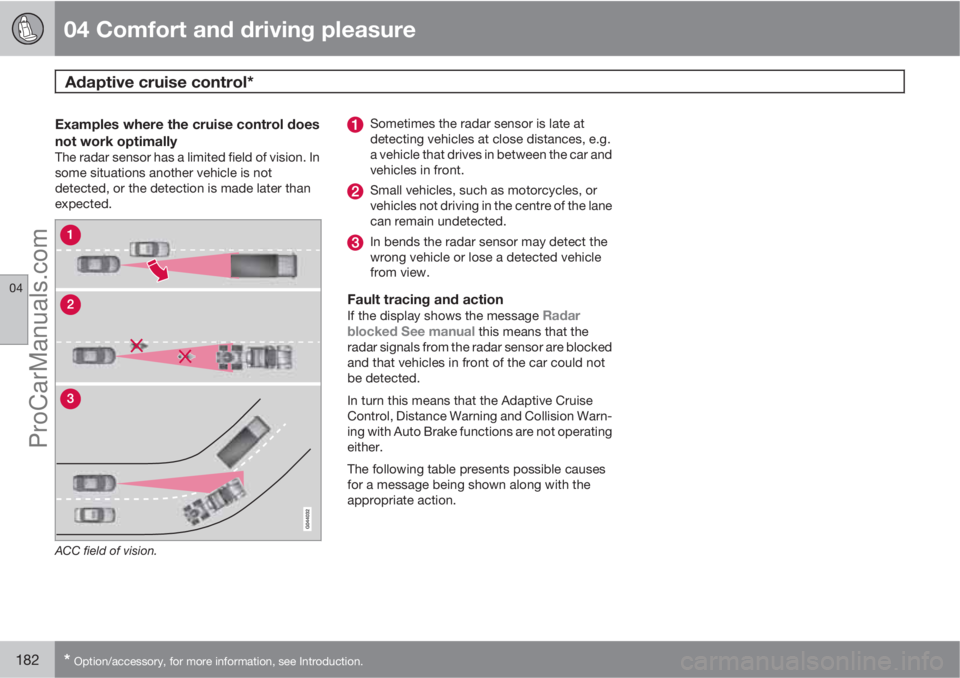
04 Comfort and driving pleasure
Adaptive cruise control*
04
182* Option/accessory, for more information, see Introduction.
Examples where the cruise control does
not work optimally
The radar sensor has a limited field of vision. In
some situations another vehicle is not
detected, or the detection is made later than
expected.
ACC field of vision.
Sometimes the radar sensor is late at
detecting vehicles at close distances, e.g.
a vehicle that drives in between the car and
vehicles in front.
Small vehicles, such as motorcycles, or
vehicles not driving in the centre of the lane
can remain undetected.
In bends the radar sensor may detect the
wrong vehicle or lose a detected vehicle
from view.
Fault tracing and action
If the display shows the message Radar
blocked See manual this means that the
radar signals from the radar sensor are blocked
and that vehicles in front of the car could not
be detected.
In turn this means that the Adaptive Cruise
Control, Distance Warning and Collision Warn-
ing with Auto Brake functions are not operating
either.
The following table presents possible causes
for a message being shown along with the
appropriate action.
ProCarManuals.com
Page 186 of 400
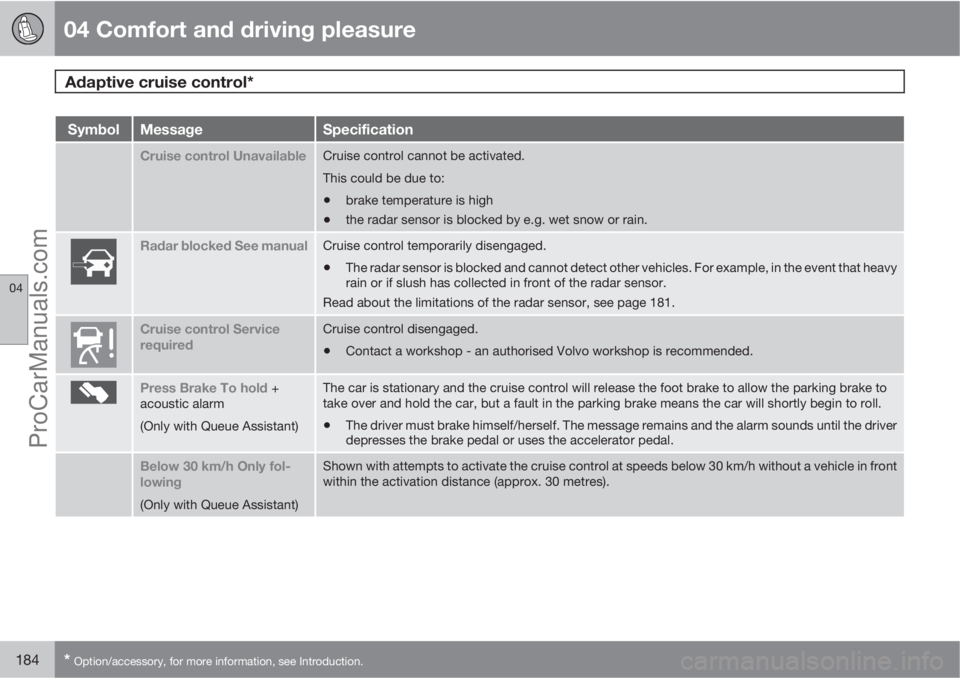
04 Comfort and driving pleasure
Adaptive cruise control*
04
184* Option/accessory, for more information, see Introduction.
SymbolMessageSpecification
Cruise control UnavailableCruise control cannot be activated.
This could be due to:
•brake temperature is high
•the radar sensor is blocked by e.g. wet snow or rain.
Radar blocked See manualCruise control temporarily disengaged.
•The radar sensor is blocked and cannot detect other vehicles. For example, in the event that heavy
rain or if slush has collected in front of the radar sensor.
Read about the limitations of the radar sensor, see page 181.
Cruise control Service
requiredCruise control disengaged.
•Contact a workshop - an authorised Volvo workshop is recommended.
Press Brake To hold +
acoustic alarm
(Only with Queue Assistant)The car is stationary and the cruise control will release the foot brake to allow the parking brake to
take over and hold the car, but a fault in the parking brake means the car will shortly begin to roll.
•The driver must brake himself/herself. The message remains and the alarm sounds until the driver
depresses the brake pedal or uses the accelerator pedal.
Below 30 km/h Only fol-
lowing
(Only with Queue Assistant)
Shown with attempts to activate the cruise control at speeds below 30 km/h without a vehicle in front
within the activation distance (approx. 30 metres).
ProCarManuals.com
Page 188 of 400
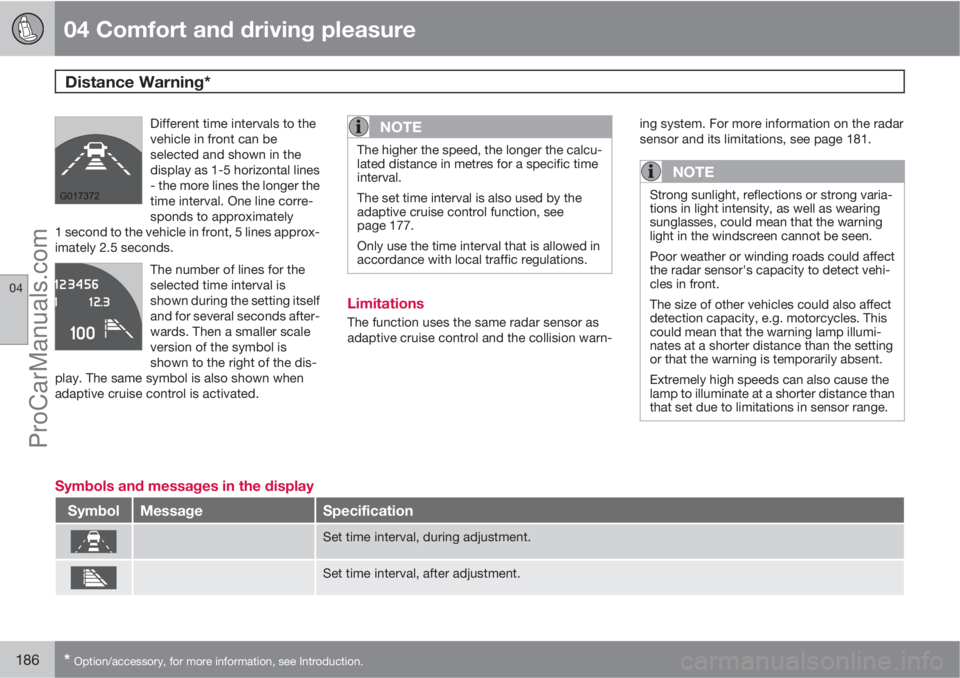
04 Comfort and driving pleasure
Distance Warning*
04
186* Option/accessory, for more information, see Introduction.
Different time intervals to the
vehicle in front can be
selected and shown in the
display as 1-5 horizontal lines
- the more lines the longer the
time interval. One line corre-
sponds to approximately
1 second to the vehicle in front, 5 lines approx-
imately 2.5 seconds.
The number of lines for the
selected time interval is
shown during the setting itself
and for several seconds after-
wards. Then a smaller scale
version of the symbol is
shown to the right of the dis-
play. The same symbol is also shown when
adaptive cruise control is activated.
NOTE
The higher the speed, the longer the calcu-
lated distance in metres for a specific time
interval.
The set time interval is also used by the
adaptive cruise control function, see
page 177.
Only use the time interval that is allowed in
accordance with local traffic regulations.
Limitations
The function uses the same radar sensor as
adaptive cruise control and the collision warn-ing system. For more information on the radar
sensor and its limitations, see page 181.
NOTE
Strong sunlight, reflections or strong varia-
tions in light intensity, as well as wearing
sunglasses, could mean that the warning
light in the windscreen cannot be seen.
Poor weather or winding roads could affect
the radar sensor's capacity to detect vehi-
cles in front.
The size of other vehicles could also affect
detection capacity, e.g. motorcycles. This
could mean that the warning lamp illumi-
nates at a shorter distance than the setting
or that the warning is temporarily absent.
Extremely high speeds can also cause the
lamp to illuminate at a shorter distance than
that set due to limitations in sensor range.
Symbols and messages in the display
SymbolMessageSpecification
Set time interval, during adjustment.
Set time interval, after adjustment.
ProCarManuals.com
Page 189 of 400
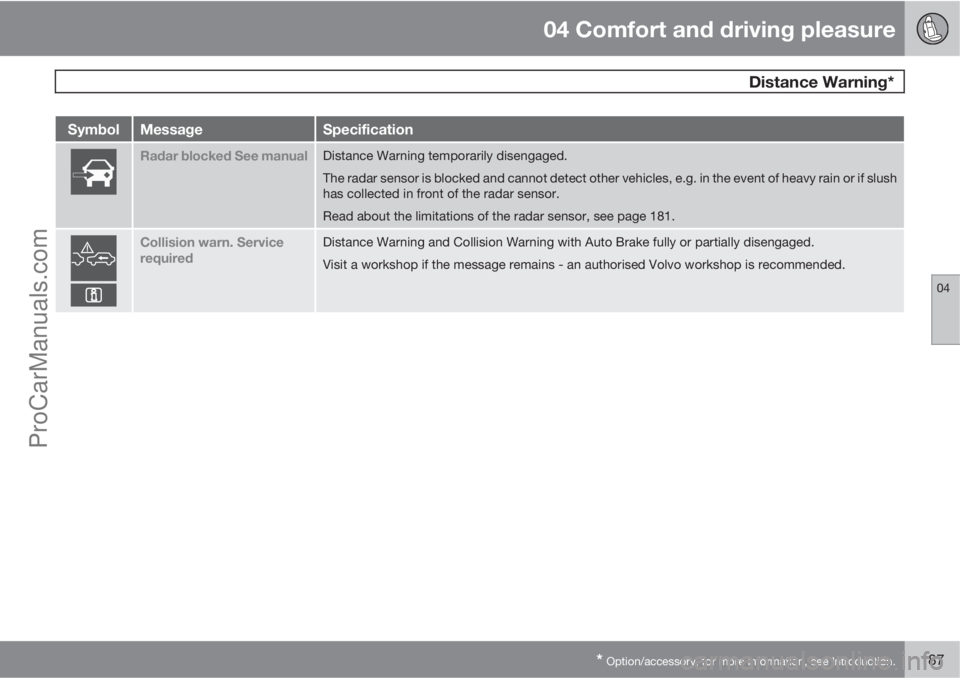
04 Comfort and driving pleasure
Distance Warning*
04
* Option/accessory, for more information, see Introduction.187
SymbolMessageSpecification
Radar blocked See manualDistance Warning temporarily disengaged.
The radar sensor is blocked and cannot detect other vehicles, e.g. in the event of heavy rain or if slush
has collected in front of the radar sensor.
Read about the limitations of the radar sensor, see page 181.
Collision warn. Service
requiredDistance Warning and Collision Warning with Auto Brake fully or partially disengaged.
Visit a workshop if the message remains - an authorised Volvo workshop is recommended.
ProCarManuals.com
Page 190 of 400
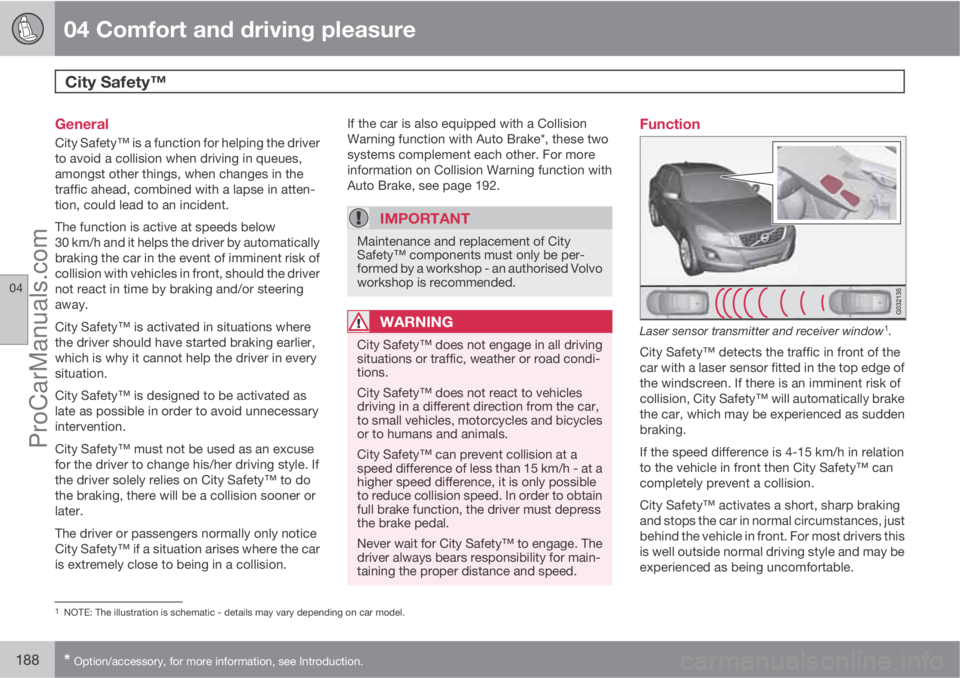
04 Comfort and driving pleasure
City Safety™
04
188* Option/accessory, for more information, see Introduction.
General
City Safety™ is a function for helping the driver
to avoid a collision when driving in queues,
amongst other things, when changes in the
traffic ahead, combined with a lapse in atten-
tion, could lead to an incident.
The function is active at speeds below
30 km/h and it helps the driver by automatically
braking the car in the event of imminent risk of
collision with vehicles in front, should the driver
not react in time by braking and/or steering
away.
City Safety™ is activated in situations where
the driver should have started braking earlier,
which is why it cannot help the driver in every
situation.
City Safety™ is designed to be activated as
late as possible in order to avoid unnecessary
intervention.
City Safety™ must not be used as an excuse
for the driver to change his/her driving style. If
the driver solely relies on City Safety™ to do
the braking, there will be a collision sooner or
later.
The driver or passengers normally only notice
City Safety™ if a situation arises where the car
is extremely close to being in a collision.If the car is also equipped with a Collision
Warning function with Auto Brake*, these two
systems complement each other. For more
information on Collision Warning function with
Auto Brake, see page 192.
IMPORTANT
Maintenance and replacement of City
Safety™ components must only be per-
formed by a workshop - an authorised Volvo
workshop is recommended.
WARNING
City Safety™ does not engage in all driving
situations or traffic, weather or road condi-
tions.
City Safety™ does not react to vehicles
driving in a different direction from the car,
to small vehicles, motorcycles and bicycles
or to humans and animals.
City Safety™ can prevent collision at a
speed difference of less than 15 km/h - at a
higher speed difference, it is only possible
to reduce collision speed. In order to obtain
full brake function, the driver must depress
the brake pedal.
Never wait for City Safety™ to engage. The
driver always bears responsibility for main-
taining the proper distance and speed.
Function
Laser sensor transmitter and receiver window1.
City Safety™ detects the traffic in front of the
car with a laser sensor fitted in the top edge of
the windscreen. If there is an imminent risk of
collision, City Safety™ will automatically brake
the car, which may be experienced as sudden
braking.
If the speed difference is 4-15 km/h in relation
to the vehicle in front then City Safety™ can
completely prevent a collision.
City Safety™ activates a short, sharp braking
and stops the car in normal circumstances, just
behind the vehicle in front. For most drivers this
is well outside normal driving style and may be
experienced as being uncomfortable.
1NOTE: The illustration is schematic - details may vary depending on car model.
ProCarManuals.com
Page 191 of 400
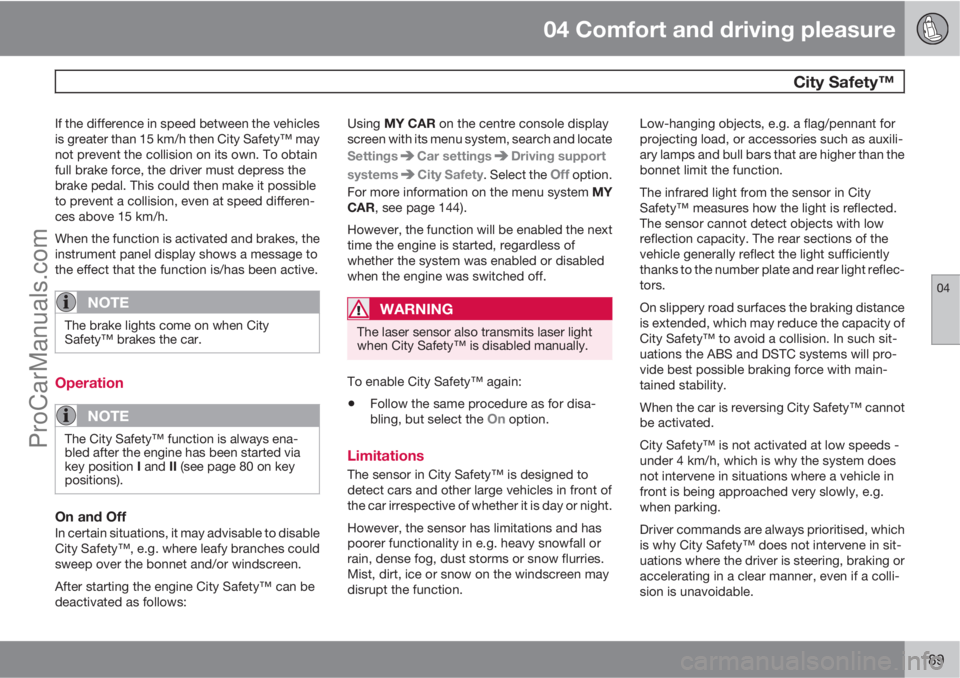
04 Comfort and driving pleasure
City Safety™
04
189
If the difference in speed between the vehicles
is greater than 15 km/h then City Safety™ may
not prevent the collision on its own. To obtain
full brake force, the driver must depress the
brake pedal. This could then make it possible
to prevent a collision, even at speed differen-
ces above 15 km/h.
When the function is activated and brakes, the
instrument panel display shows a message to
the effect that the function is/has been active.
NOTE
The brake lights come on when City
Safety™ brakes the car.
Operation
NOTE
The City Safety™ function is always ena-
bled after the engine has been started via
key position I and II (see page 80 on key
positions).
On and OffIn certain situations, it may advisable to disable
City Safety™, e.g. where leafy branches could
sweep over the bonnet and/or windscreen.
After starting the engine City Safety™ can be
deactivated as follows:Using MY CAR on the centre console display
screen with its menu system, search and locate
Settings
Car settingsDriving support
systems
City Safety. Select the Off option.
For more information on the menu system MY
CAR, see page 144).
However, the function will be enabled the next
time the engine is started, regardless of
whether the system was enabled or disabled
when the engine was switched off.
WARNING
The laser sensor also transmits laser light
when City Safety™ is disabled manually.
To enable City Safety™ again:
•Follow the same procedure as for disa-
bling, but select the On option.
Limitations
The sensor in City Safety™ is designed to
detect cars and other large vehicles in front of
the car irrespective of whether it is day or night.
However, the sensor has limitations and has
poorer functionality in e.g. heavy snowfall or
rain, dense fog, dust storms or snow flurries.
Mist, dirt, ice or snow on the windscreen may
disrupt the function.Low-hanging objects, e.g. a flag/pennant for
projecting load, or accessories such as auxili-
ary lamps and bull bars that are higher than the
bonnet limit the function.
The infrared light from the sensor in City
Safety™ measures how the light is reflected.
The sensor cannot detect objects with low
reflection capacity. The rear sections of the
vehicle generally reflect the light sufficiently
thanks to the number plate and rear light reflec-
tors.
On slippery road surfaces the braking distance
is extended, which may reduce the capacity of
City Safety™ to avoid a collision. In such sit-
uations the ABS and DSTC systems will pro-
vide best possible braking force with main-
tained stability.
When the car is reversing City Safety™ cannot
be activated.
City Safety™ is not activated at low speeds -
under 4 km/h, which is why the system does
not intervene in situations where a vehicle in
front is being approached very slowly, e.g.
when parking.
Driver commands are always prioritised, which
is why City Safety™ does not intervene in sit-
uations where the driver is steering, braking or
accelerating in a clear manner, even if a colli-
sion is unavoidable.
ProCarManuals.com
Page 192 of 400
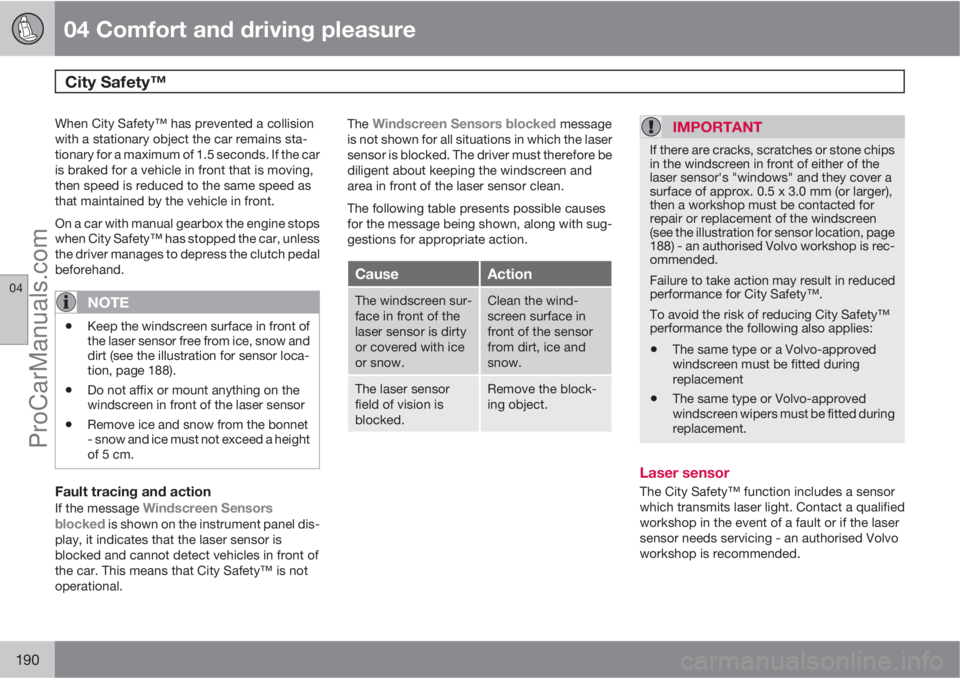
04 Comfort and driving pleasure
City Safety™
04
190
When City Safety™ has prevented a collision
with a stationary object the car remains sta-
tionary for a maximum of 1.5 seconds. If the car
is braked for a vehicle in front that is moving,
then speed is reduced to the same speed as
that maintained by the vehicle in front.
On a car with manual gearbox the engine stops
when City Safety™ has stopped the car, unless
the driver manages to depress the clutch pedal
beforehand.
NOTE
•Keep the windscreen surface in front of
the laser sensor free from ice, snow and
dirt (see the illustration for sensor loca-
tion, page 188).
•Do not affix or mount anything on the
windscreen in front of the laser sensor
•Remove ice and snow from the bonnet
- snow and ice must not exceed a height
of 5 cm.
Fault tracing and action
If the message Windscreen Sensors
blocked is shown on the instrument panel dis-
play, it indicates that the laser sensor is
blocked and cannot detect vehicles in front of
the car. This means that City Safety™ is not
operational.The
Windscreen Sensors blocked message
is not shown for all situations in which the laser
sensor is blocked. The driver must therefore be
diligent about keeping the windscreen and
area in front of the laser sensor clean.
The following table presents possible causes
for the message being shown, along with sug-
gestions for appropriate action.
CauseAction
The windscreen sur-
face in front of the
laser sensor is dirty
or covered with ice
or snow.Clean the wind-
screen surface in
front of the sensor
from dirt, ice and
snow.
The laser sensor
field of vision is
blocked.Remove the block-
ing object.
IMPORTANT
If there are cracks, scratches or stone chips
in the windscreen in front of either of the
laser sensor's "windows" and they cover a
surface of approx. 0.5 x 3.0 mm (or larger),
then a workshop must be contacted for
repair or replacement of the windscreen
(see the illustration for sensor location, page
188) - an authorised Volvo workshop is rec-
ommended.
Failure to take action may result in reduced
performance for City Safety™.
To avoid the risk of reducing City Safety™
performance the following also applies:
•The same type or a Volvo-approved
windscreen must be fitted during
replacement
•The same type or Volvo-approved
windscreen wipers must be fitted during
replacement.
Laser sensor
The City Safety™ function includes a sensor
which transmits laser light. Contact a qualified
workshop in the event of a fault or if the laser
sensor needs servicing - an authorised Volvo
workshop is recommended.
ProCarManuals.com
Page 193 of 400
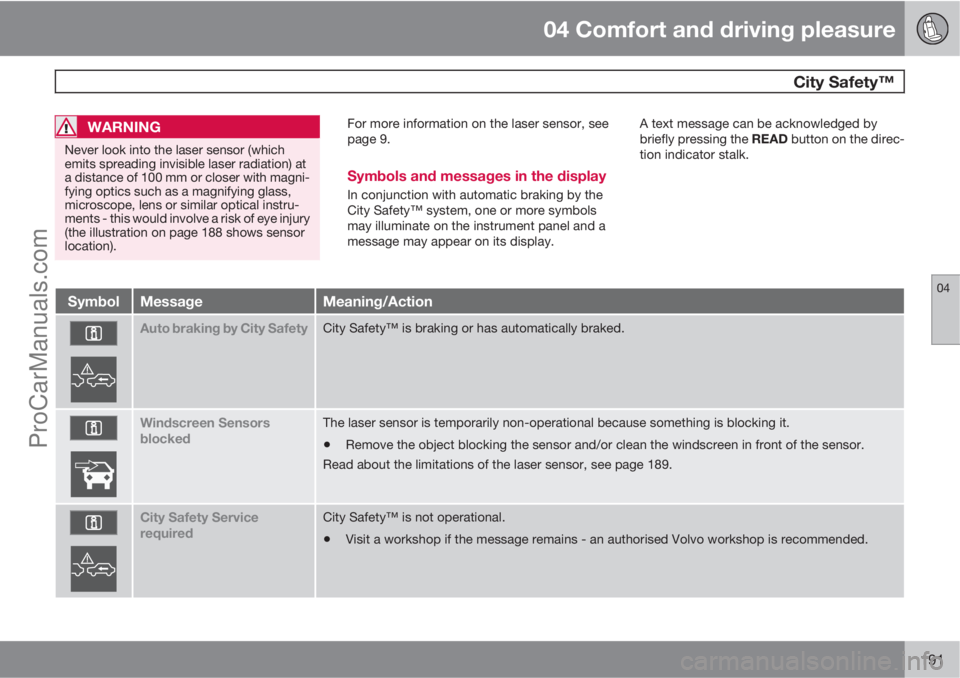
04 Comfort and driving pleasure
City Safety™
04
191
WARNING
Never look into the laser sensor (which
emits spreading invisible laser radiation) at
a distance of 100 mm or closer with magni-
fying optics such as a magnifying glass,
microscope, lens or similar optical instru-
ments - this would involve a risk of eye injury
(the illustration on page 188 shows sensor
location).
For more information on the laser sensor, see
page 9.
Symbols and messages in the display
In conjunction with automatic braking by the
City Safety™ system, one or more symbols
may illuminate on the instrument panel and a
message may appear on its display.A text message can be acknowledged by
briefly pressing the READ button on the direc-
tion indicator stalk.
SymbolMessageMeaning/Action
Auto braking by City SafetyCity Safety™ is braking or has automatically braked.
Windscreen Sensors
blockedThe laser sensor is temporarily non-operational because something is blocking it.
•Remove the object blocking the sensor and/or clean the windscreen in front of the sensor.
Read about the limitations of the laser sensor, see page 189.
City Safety Service
requiredCity Safety™ is not operational.
•Visit a workshop if the message remains - an authorised Volvo workshop is recommended.
ProCarManuals.com